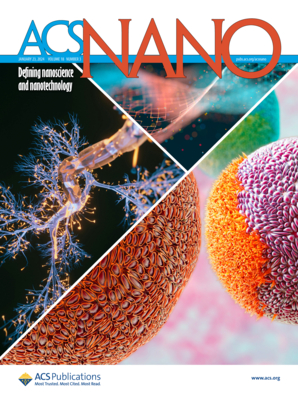Boosting Cancer Cell Uptake of Gold Nanoparticles by Light-Modulated Protein Corona Reorganization for Tumor Ablation
IF 15.8
1区 材料科学
Q1 CHEMISTRY, MULTIDISCIPLINARY
引用次数: 0
Abstract
Nanoparticles (NPs) administered into the human body are spontaneously modified by forming a protein corona, which is crucial for their biological activity. While NP-based photothermal therapy is an established noninvasive modality for tumor ablation, the impact of light irradiation on protein corona formation and clinical outcomes is unclear. This study unveils the promotive role of light irradiation in cancer cell uptake of gold nanoparticles (GNPs) by modulating the GNP–protein and protein–protein interactions within the corona. Specifically, infrared light irradiation increases the local temperature around GNPs to induce partial unfolding of corona proteins, increasing the availability of binding sites and enhancing adsorption. Additionally, light intensifies competition among different proteins for adsorption, resulting in a 25% increase in the abundance of higher molecular weight proteins, such as human serum albumin (HSA), on the GNP surface after irradiation. Notably, GNPs with positively charged surfaces, compared to GNPs with other modifications, exhibit more significant changes in the protein corona due to stronger electrostatic interactions with proteins (1.32 ± 0.17 × 103 kJ/mol). These variations in the amount, structure, and composition of associated proteins result in a 14.26% increase in GNP uptake by cancer cells, likely due to modifications at the GNP–cell membrane interface. Our findings highlight the critical role of light irradiation in influencing protein corona dynamics and cellular interactions, suggesting its potential as a valuable engineering tool in nanomedicine.

求助全文
约1分钟内获得全文
求助全文
来源期刊

ACS Nano
工程技术-材料科学:综合
CiteScore
26.00
自引率
4.10%
发文量
1627
审稿时长
1.7 months
期刊介绍:
ACS Nano, published monthly, serves as an international forum for comprehensive articles on nanoscience and nanotechnology research at the intersections of chemistry, biology, materials science, physics, and engineering. The journal fosters communication among scientists in these communities, facilitating collaboration, new research opportunities, and advancements through discoveries. ACS Nano covers synthesis, assembly, characterization, theory, and simulation of nanostructures, nanobiotechnology, nanofabrication, methods and tools for nanoscience and nanotechnology, and self- and directed-assembly. Alongside original research articles, it offers thorough reviews, perspectives on cutting-edge research, and discussions envisioning the future of nanoscience and nanotechnology.
 求助内容:
求助内容: 应助结果提醒方式:
应助结果提醒方式:


